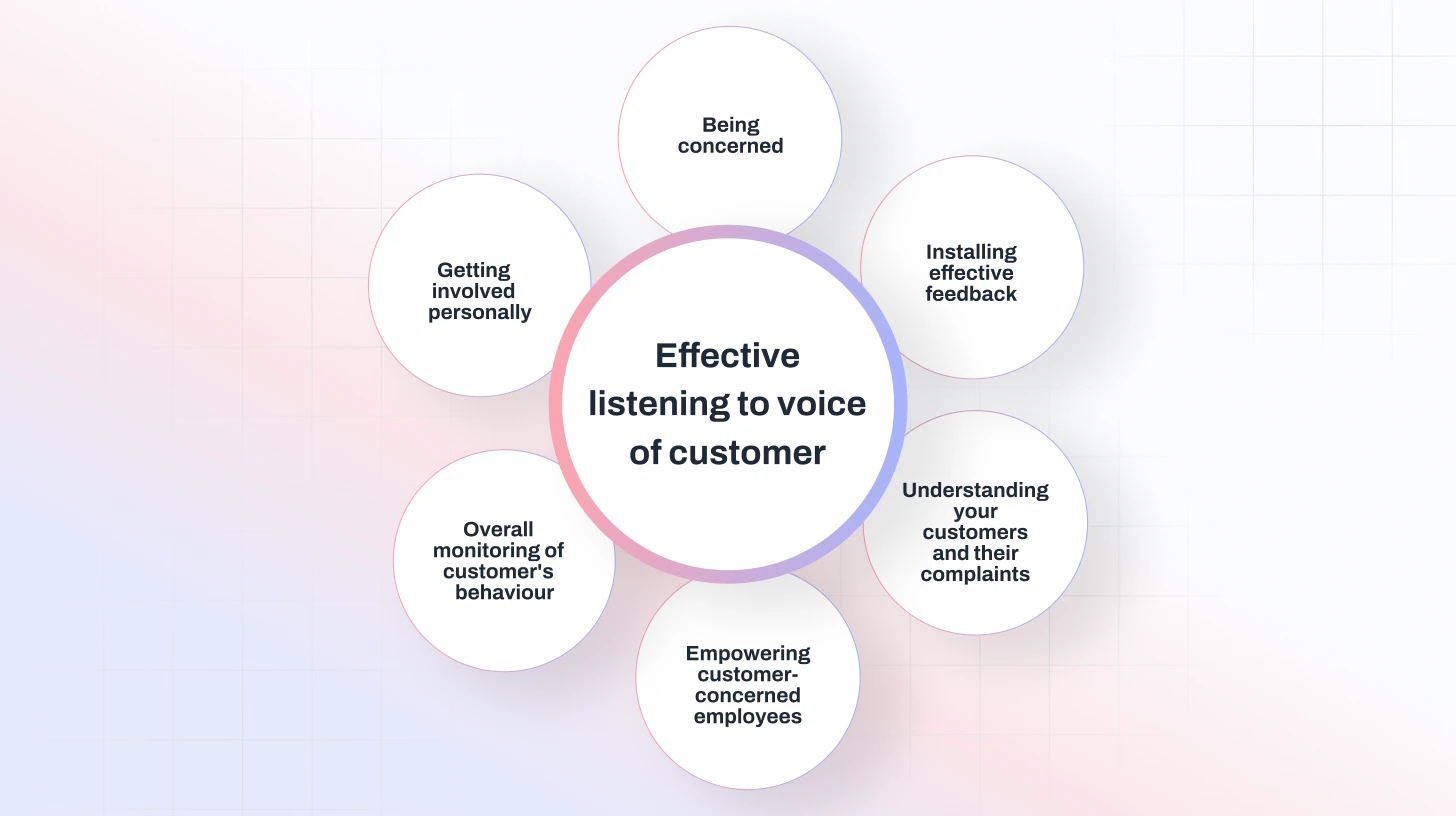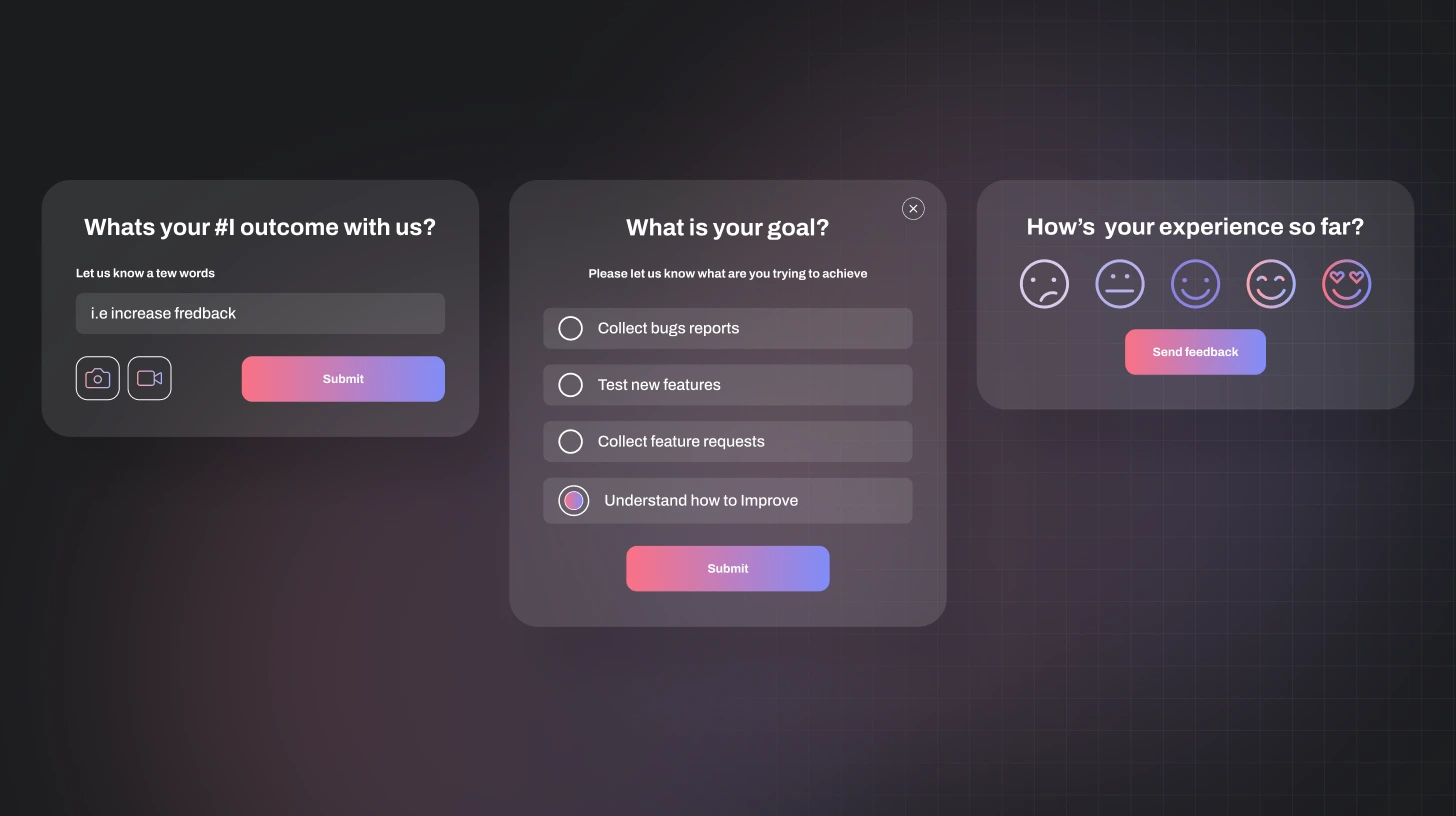 Blog
Blog 60 Voice of Customer Survey Questions to Improve Customer Experience
60 Voice of Customer Survey Questions to Improve Customer Experience60 Voice of Customer Survey Questions to Improve Customer Experience

A voice of the customer program is as strong as the questions behind it. The survey is your main tool, and if it’s not sharp, the insights won’t cut deep. But it's very tempting to ask everything at once. Who wouldn’t want to know every little detail about what customers think? But most people won’t sit through a long survey. You’re lucky to get three to five minutes of their attention.
That’s why the questions you pick matter so much. A short, focused list can reveal more truth than a hundred random ones.
Your Voice of Customer survey should match your goal. Are you testing a product idea? Measuring satisfaction? Looking for reasons behind churn? Each situation calls for a different kind of question.
Below, you’ll find 60 Voice of Customer survey questions you can use or adapt to pull honest answers, not polite ones. And if you’re ready to collect and understand feedback without juggling tools, TheySaid makes the whole process easier from asking questions to turning responses into action.
What is the voice of the customer survey?
A Voice of Customer (VoC) survey is a tool to gather feedback from customers about a product, service, or overall experience.
Here are some facts:
- Around 85% of companies say customer satisfaction is a key part of business success, but only 14% believe customer experience is their strongest capability. Source
- 51% of customers say they’ve avoided acting on a problem in the past year — simply because dealing with support felt like too much hassle. Source
- Companies that deliver better customer experience see revenue growth rates of 1.5‑8% higher than their peers. Source
The takeaway: VoC surveys are one of the best ways to find out what your customers think, feel, and expect if you ask the right questions.
The Importance of Asking the Right VoC Questions
Imagine that your company wants to improve its product. You decide to run a VoC survey to understand what customers like and dislike.
You send a short survey to your users asking for feedback. Replies start coming in, and you feel like you’re making progress.
But as you review the answers, you realize most responses are vague or off-topic. They don’t help you figure out what features to improve or what problems to solve.
Why?
The questions weren’t clear or focused. Poorly designed questions lead to weak insights, and weak insights lead to poor decisions.
Ask weak questions, get weak insights.
The right VoC questions get to the heart of what matters. They reveal real opinions, frustrations, and priorities, the stuff that actually guides action.
Read: Understanding and Measuring Customer Experience ROI

Questions to Ask Before Sending a VoC Survey
Before sending the VoC survey, take a step back. Answering a few key questions first can make the difference between actionable insights and wasted responses.
What is the goal of your survey?: Define your objectives clearly. It will guide which questions you ask.
Who should take your survey?: Choose your audience carefully. New users might not have enough experience yet, while long-term customers can offer deeper insights.
Are you collecting quantitative or qualitative feedback?: Quantitative questions (ratings, scales, multiple choice) give you measurable data. Qualitative questions (open-ended responses) reveal customer opinions, frustrations, and ideas.
Are your questions simple and clear?: Keep questions short and easy to understand. Avoid jargon, long sentences, or complex wording. Clarity leads to honest, complete answers.
Are the answer options appropriate?: Choose formats that fit the question: rating scales, yes/no, multiple choice, or open-ended. The right format makes it easier for customers to respond and gives you usable data.
Will you follow up on responses?: Some surveys, like Net Promoter Score (NPS), require follow-up with unhappy customers. Listening is important, but acting on feedback is what retains customers and builds trust.
60 Best Voice of Customer Survey Questions
VoC Questions to Assess Your Brand Recognition and Awareness
Understanding how your customers perceive and recognize your brand is a key part of any Voice of Customer (VoC) program. These questions help you measure brand awareness, identify gaps, and discover how your company is positioned in the minds of your audience.
Here are some examples of effective VoC questions for brand recognition and awareness:
- How did you first hear about [COMPANY/BRAND]?
- Which of the following brands are you familiar with in [PRODUCT/INDUSTRY]?
- How often do you think about or encounter our brand?
- Which words or phrases come to mind when you think of [COMPANY/BRAND]?
- How would you rate your overall awareness of our brand compared to competitors?
- Have you seen any advertising or promotions from our company recently?
- On a scale of 1–10, how familiar are you with our products/services?
- How likely are you to recommend our brand to someone else based on recognition alone?
- Which features or products of our brand do you recall most easily?
- Open-ended: What makes [COMPANY/BRAND] stand out to you compared to others in the market?
VoC Questions to Assess Communication Preferences
These questions help you understand how your customers want to interact with your brand.
- How do you prefer to receive updates from [COMPANY/BRAND]?
- Which social media channels do you use most often? [Facebook, LinkedIn, Instagram, Twitter, etc.]
- How frequently would you like to hear from us?
- Do you prefer emails, push notifications, or SMS for updates?
- Which type of content do you find most useful from our brand?
- How clear and helpful are the messages you currently receive from us?
- How responsive do you expect us to be when you reach out?
- Are there channels we aren’t using that you would like us to?
- On a scale of 1–10, how satisfied are you with our current communication?
- Open-ended: What could we do to improve the way we communicate with you?
VoC Questions to Compare Your Brand Against Competitors
These questions help you identify your strengths, weaknesses, and competitive position.
- How does [COMPANY/BRAND] compare to competitors in terms of quality?
- How does [COMPANY/BRAND] compare in terms of price?
- Which company do you usually buy [PRODUCT/SERVICE] from besides us?
- How does our service speed compare to other companies you’ve used?
- How likely are you to choose a competitor over us, and why?
- How do we compare in customer service experience?
- Which brand do you feel delivers the best overall value for [PRODUCT/SERVICE]?
- Have you switched from another company to ours in the past year? If yes, why?
- How do our competitors outperform us, if at all?
- Open-ended: What do you think we could do better than our competitors?
VoC Questions to Test New Product or Service Concepts
These questions help gauge interest in new ideas before launch.
- How appealing would the following new features be to you? [LIST]
- Which potential new product/service would you try first?
- How likely would you be to adopt a new [PRODUCT/SERVICE] if launched?
- What would prevent you from trying a new product/service from us?
- How much value would you place on [NEW FEATURE/PRODUCT] compared to existing offerings?
- How easy would it be for you to integrate this new product/service into your routine?
- How important are these potential features when making a purchase decision?
- Would you pay more for additional features?
- Would you recommend a new product/service to someone else based on this concept?
- Open-ended: What features or improvements would make this concept more appealing to you?
VoC Questions to Understand Customer Usage and History
These questions uncover how your customers interact with your products or services.
- Have you purchased any [PRODUCT/SERVICE] from us in the past 12 months?
- Which of our products/services have you used?
- How frequently do you use our products/services?
- Approximately how long have you been a customer?
- How often do you interact with our brand online or offline?
- Have you ever contacted support? How was your experience?
- How easy is it to find the products/services you need from us?
- Have you ever faced issues that prevented you from completing a purchase?
- Are there products or services you wish we offered?
- Open-ended: What is your overall impression of being our customer?
VoC Questions to Explore Purchase Decision Factors
These questions reveal what influences your customers’ buying choices.
- What factors matter most when choosing a company for [PRODUCT/SERVICE]?
- How important is price when selecting a provider?
- How important is quality or reliability in your decision?
- How much does brand reputation influence your choice?
- Which factors would make you switch to another provider?
- Do you research reviews before buying [PRODUCT/SERVICE]?
- How important is customer support in your purchasing decision?
- How much does ease of use impact your decision?
- Do promotions or discounts influence your choice?
- Open-ended: What is the main reason you chose our company over others?
VoC Questions to Gather Feedback and Improvement Suggestions
These questions provide actionable insights to enhance your products or services.
- What’s the one thing we could do better?
- Are there obstacles you face while using our products/services?
- How could we make your experience faster or easier?
- What would encourage you to use our products/services more often?
- Are there features you wish we offered?
- How can we improve our website/app navigation?
- How can we make our customer support more helpful?
- How could we make our communication more useful to you?
- How likely are you to share your feedback with friends or colleagues?
- Open-ended: Any other suggestions or feedback to help us improve your experience?

Best Practices of Voice of Customer (VoC) Survey
Building an effective Voice of the Customer survey takes intention and clarity. Here are some proven tips and best practices to help you craft a survey voice that delivers meaningful insights.
Ask Questions in Customer Language
Write your voice of customer survey questions the way your customers talk. Avoid jargon or technical terms. For example, instead of asking “How satisfied are you with our CRM integration workflow?” ask “How easy is it to use our product?”
Test Your Questions First
Before sending your survey widely, test it with a small group. This helps you identify confusing questions and ensures responses are useful.
Segment Your Audience
Not all customers are the same. Segment your survey based on recent purchases, usage, or engagement level. Targeted surveys get better responses and more actionable insights.
Time Your Surveys Carefully
Send surveys at the right moment. After a purchase, after a support interaction, or after a product trial, when the experience is fresh. Timing affects response rates and accuracy.
Make It Easy to Respond
Surveys should work on mobile and desktop. Keep navigation simple. Minimize the number of required fields. The easier it is to respond, the more feedback you’ll get.
Personalize Where Possible
Use your customer’s name, mention their recent product or interaction. Personalized surveys feel more relevant and increase response rates.
Close the Loop
Act on what you learn. Share improvements with customers, thank them for feedback, and show that their voice matters. Closing the loop builds trust and loyalty.
Create Voice of Customer (VoC) surveys with TheySaid
We’ve talked about asking the right questions, keeping surveys short, and actually listening to your customers. Now it’s time to put that into practice, and TheySaid makes it easy.
With TheySaid, you can turn surveys into real conversations and get insights that actually guide decisions. Here’s what makes it different:
- Conversational Surveys: AI chats with your customers instead of boring forms.
- Voice Feedback & Two-Way Voice: Customers can respond with voice, and AI can interact in real time.
- Teach AI: Train the AI on your product, terminology, and brand voice.
- Instant Insight Summaries: Get structured, actionable insights in seconds.
- Predictive Insights: Spot churn risks and expansion opportunities before they happen.
- Multi-Channel Delivery: Reach customers via email, in-app, SMS, Slack, or CRM.
Stop guessing what your customers think. Start listening, learning, and acting.
Sign up for TheySaid and start creating smarter, high-response VoC surveys today.
Key Takeaways
- Focus on asking clear, goal-oriented questions that reveal actionable insights.
- Keep surveys short (3–5 minutes) to maximize response rates.
- Segment your audience to tailor questions for different customer groups.
- Use a mix of quantitative and qualitative questions to capture both measurable data and detailed opinions.
- Test your survey with a small group before launching widely to ensure clarity.
- Send surveys at the right time after purchases, support interactions, or product trials.
- Make responding easy on all devices and minimize required fields.
- Personalize surveys using customer names or recent interactions to boost engagement.
- Analyze responses to identify trends, prioritize improvements, and close the feedback loop.
- Use AI tools like TheySaid to automate surveys, summarize insights, and take faster action.
FAQs
What is a Voice of Customer (VoC) survey and why is it important?
A VoC survey collects customer feedback to understand their experiences and expectations, helping businesses improve satisfaction and loyalty.
How do I write effective Voice of Customer survey questions?
Write clear, simple questions in customer language, using a mix of ratings and open-ended questions. Keep surveys short and goal-focused.
How can I use VoC survey feedback to improve my products or services?
Analyze responses to spot trends, prioritize improvements, and act on feedback to enhance products, services, and customer trust.
















.svg)